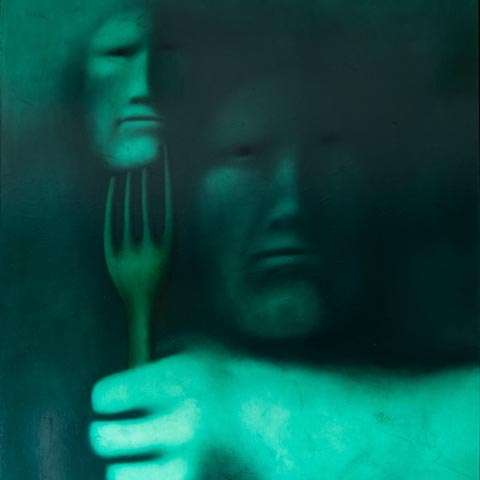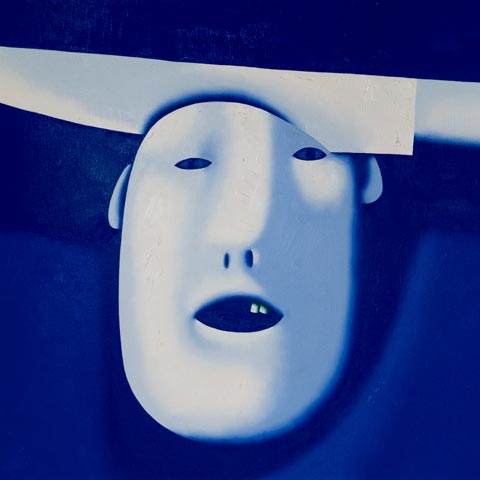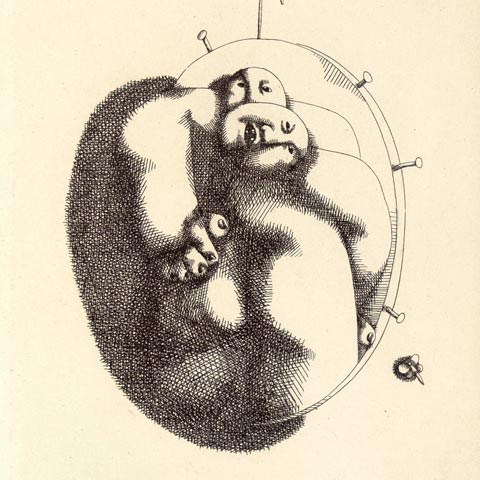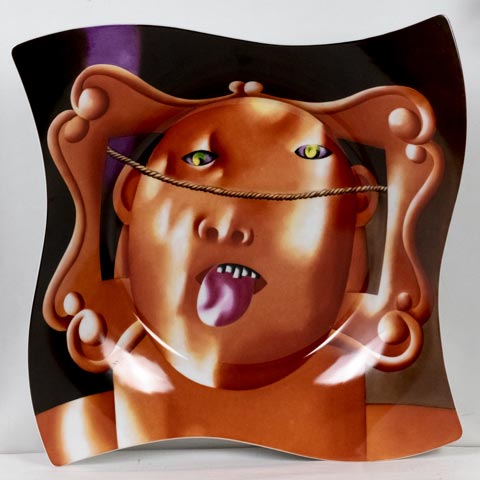
— Are there any talented painters among them?
— Yes. For example, Tselkov.
— Which one is that? In jeans?
— Tselkov is the one who did not come.
The sparkling dialogue from Sergei Dovlatov's “Reserve” is not his only dithyramb to the vivid artist. In 1977, Oleg Tselkov (1934–2021) was going into exile with the status, if not of a living legend, then certainly of an underground celebrity. This “enfant terrible” was kicked out of the Union of Artists, worked on the decorations of provincial theatres for reference, and was deprived of exhibition opportunities. At the same time he was not a political dissident. Tselkov did not participate in the Bulldozer exhibition, shunned loud statements, did not adhere to any influential “circle” or “group”. But at the same time he drank with Yevtushenko and Siqueiros, was friends with Akhmadulina, sipped wine with Akhmatova and sold paintings to the diplomats of the Costakis circle. He lived as if the devil himself were not his brother.
Of course, the Soviet authorities had long had Tselkov on their radar. The bright upstart was kicked out of institutes — in fact, he remained self-taught. His exhibitions were mockingly closed — some after a day, others after 15 minutes. His art always reeked of unacceptable freedom and anti-Sovietism. It was inadmissible. In addition, instead of hiding behind the plinth, Tselkov had the audacity to be quite successful even in exhibition isolation. He was rumoured to be selling his paintings for fabulous money — a dollar a square centimetre. It was written in Dovlatov's “Solo on Underwood”. Tselkov also supported this legend. He only corrected that it was not a dollar per square meter, but a ruble. But this is a parable, of course. He had an “accounting” connection between price and size, but multiplying height by width doesn't even mathematically beat it. According to this formula, an 80 × 100 picture should have cost more than the “Zhiguli” — 8,000 rubles. But it really cost 100–200 rubles (also quite a lot — a monthly salary of an engineer). In particular, the painting, which today leads the rating of auction results, was purchased in 1957 by Costakis for 100 rubles (in the recalculation of pre-reform money).
Many people are disgusted by the mugs on Tselkov's canvases, even today. One can imagine how bold this optic was for the Khrushchev and Brezhnev times. Innovative faces-masks-guises appeared in the 1960s. Tselkov even named a specific painting that became an epiphany. The grotesque “Portrait” measuring 50 by 60 cm with two ugly muzzles prompted the artist to come up with a universal formula for the application of forms. He decomposed the geometry of faces into elements and began to build from them biomorphic constructions for landscapes and genre scenes. Much less is known about the philosophical basis of Tselkov's work. But here the viewer can cope on his own. We are talking about social masks, hypocrisy, and the cultivation of monstrous entities within the bodies of everyday people. There can be different interpretations. But one thing is hard to argue with. Tselkov's works are energy volcanoes. Hang them in a group exhibition and they will grab all the attention. And most importantly, the fact that they are Tselkov, will be visible from a distance of 100 meters.

Oleg Tselkov has always been among the ten most expensive artists of the post-war unofficial art. And it is a rare case where the auction record for the artist's work was not set in the blessed 2008 (the peak prices in the Russian art market was, scary to think of it, almost 15 years ago), but in 2021. A year ago, an early 1957 painting “Boy with Balloons” from the Costakis collection was sold at Sotheby's for $ 721,000. Interestingly, the same painting was bought in 2008 for $ 365,000 and that result looked unthinkable at the time. And if you remember about 100 rubles, for which it was purchased by Costakis himself, then the investment component becomes simply blatant.
In short, the numbers are spectacular. But partly even harmful. One should never confuse auction “shots” with market “backgrounds”. In the real daily auction and gallery market Tselkov's works are quite accessible to collectors of different income. Paintings from 1980s to 2000s periodically come up for auction in the range of $ 10,000–60,000 (roughly 650 000–4 000 000 rubles). Everything affects the price: size, year, subject. The most affordable are the paintings of chamber format (less than an A4 sheet) from the 1990s–2000s. They are priced in the neighborhood of $ 10,000. Large-format canvases of one-meter size are priced from $ 30,000. And certainly giants under two meters can cost $ 50,000–60,000–70,000. These are paintings after 1980.
The question of “periodicity” in Tselkov's work is not as unambiguous as, for example, in the legacy of his highly regarded Dmitry Krasnopevtsev. It happens that a valuable period begins after a particular year. But that is not the case with Tselkov. Judge for yourself. His flagship faces appeared in 1960. The transition from the narrative “crimson period” to the laconicism and outline of the gradients — this is 1979. And the most expensive auction sale confuses all the cards. That's because the record-breaking painting was painted in 1957 — long before the appearance of the valuable main theme of muzzle-faces. It's not so simple in periods in general. Yes, we know convinced collectors who appreciate Tselkov 1960's — voluminous, red, poster-bright. They want only such — and no other. But for us and many other collectors, on the contrary, Tselkov has been closer since the early 1980s, when minor details had disappeared, when emphasis was placed on color and power, and when incomparable “Rothko-like” gradients were added to the technique. Tastes differ. In fairness, it should be added that Tselkov's paintings before 1979 are quite a rarity in the auction market. Therefore, it is all the more necessary to look at things realistically and choose from the works of the last forty years: according to temperament, according to the degree of plot “hooliganism”, according to size and affordability.
In a sense, any recognizable format painting by Tselkov is a «Mercedes» in the collection of the Sixties. That is, it is a pretty clear indicator of the collection's high class — just like Krasnopevtsev or Weisberg of the valuable period on the wall. A person of some understanding will see a muzzle from the threshold — and a lot becomes immediately clear to him.

We've talked about painting. There is no point in discussing Tselkov's drawings. They are not to be found on the market, because they almost never existed. Drawings by hand were not his genre — the artist made no secret of this. From paper, Tselkov has a few subjects made in large prints in etching and lithography. They are sold in the range of 40,000–100,000 rubles. But these are things for decoration, not for investment. A special subject for investment collecting is Tselkov's sculpture and porcelain.

There are several subjects in Tselkov's porcelain. For example, Tselkov's dishes, issued in an edition of 25 copies, are bought in the region of 400,000 rubles (about $ 6,000). A set of four very beautiful statuettes can cost around $ 15,000. A vase is in the neighborhood of $ 10,000. Tselkov's porcelain was produced in small numbers. For several years, it settled in collections. Porcelain rarely comes up for auction. And due to the rarity, the price of this material is increased every year. But at the same time, the circle of porcelain collectors is markedly less than the audience of collectors of painting. And this should also be taken into account as a liquidity factor.
In spite of the complexity of the moment, interest in the work of Oleg Tselkov is growing and is supported by powerful exhibitions. Thus, immediately after the artist's death, in 2021, Tselkov's works were shown at the Multimedia Art Museum. And in the summer of 2022, an important retrospective was completed at the Moscow Museum of Modern Art. This shows that there are important driving forces behind the artist: the support of collectors, the interest of the foundations and the recognition of the museum community. And how could it be otherwise. Tselkov is in all the “textbooks”. His paintings are reproduced in the catalogues of Bar-Gera, Norton Dodge. Information about him can be found in the reference books “Other Art”, “Leonid Talochkin. Collection”, 6th issue of the magazine “А-Я”. Interviews with Tselkov were published in the books “Ideally Different” by Vadim Alekseev, “The Russian Palette of Paris” by Yuri Kovalenko. Everywhere. Not a single publication about the sixties is complete without a story about this author.
How big are the risks of falsification? Grotesque variants like “blood out of the eyes” — yes, they do occur. But complex non-obvious forgeries of Tselkov are still quite rare. Perhaps this is just for the time being. The artist only died last year. The most frequent difficulty is the attribution of early works, when his manner has not yet been fully developed. But with the 1980s–2000s, as a rule, everything is pretty obvious. Nevertheless, you need to check. Olga Schmitt, the adopted daughter of Tselkov, helps to deal with the authenticity of the works. And, of course, the main expert on the sixties is Valery Silaev.
Vladimir Bogdanov, specialist of the auction house ArtSale.info
Watch also a video review on investing in the works of Oleg Tselkov on our YouTube channel:
- Log in to post comments










